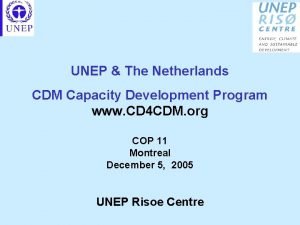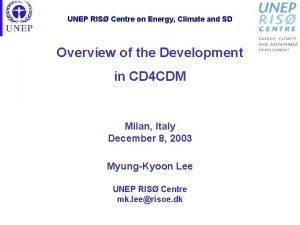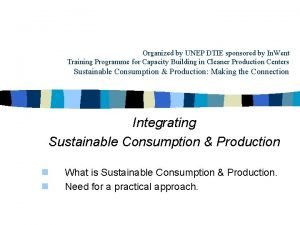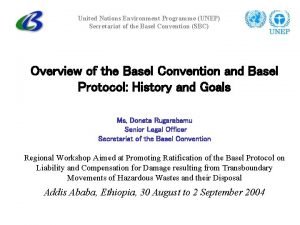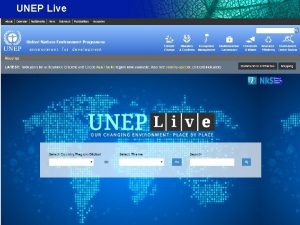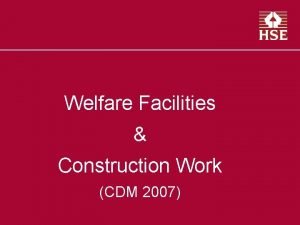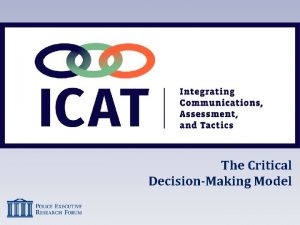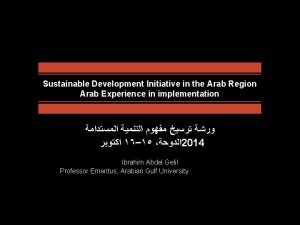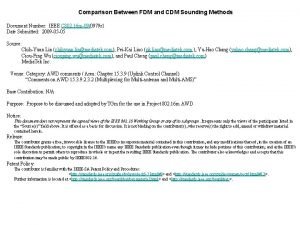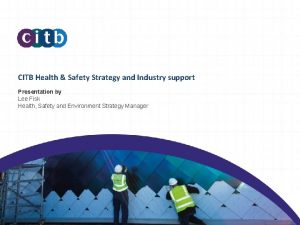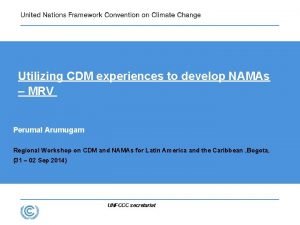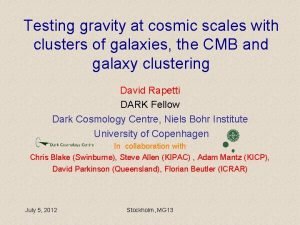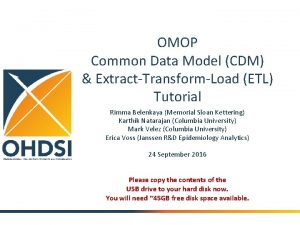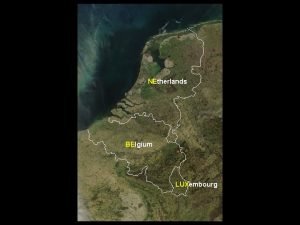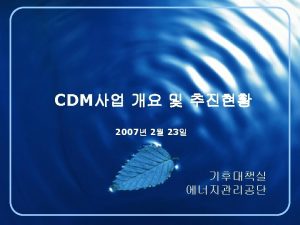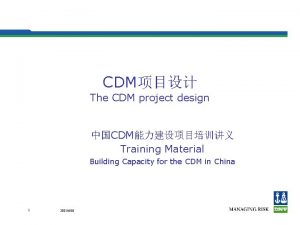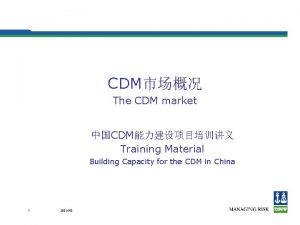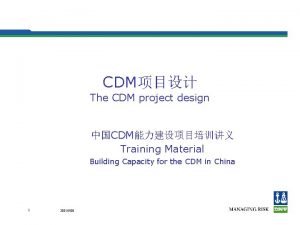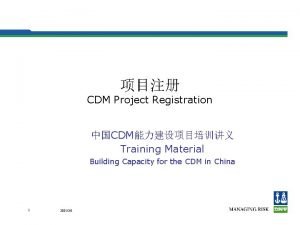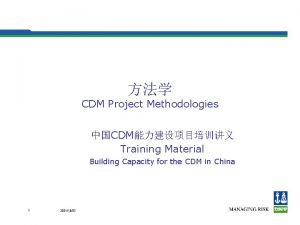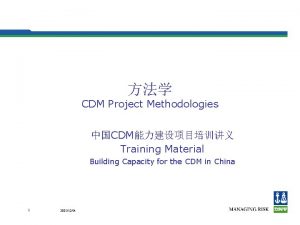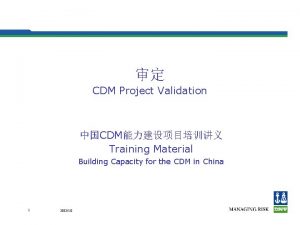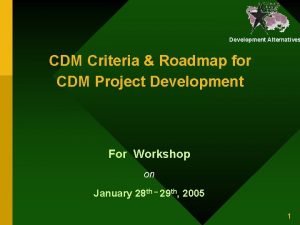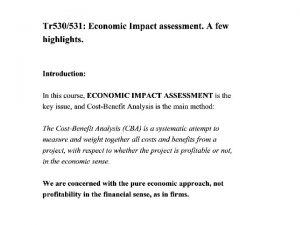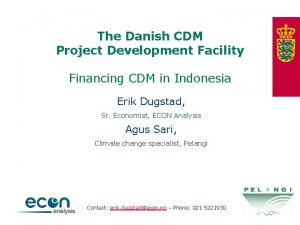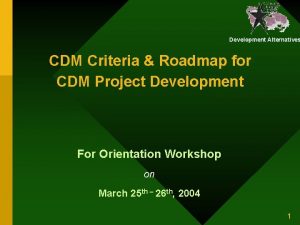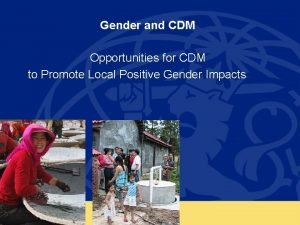UNEP The Netherlands CDM Capacity Development Program www



















- Slides: 19

UNEP & The Netherlands CDM Capacity Development Program www. CD 4 CDM. org COP 11 Montreal December 5, 2005 UNEP Risoe Centre

Outline of presentation • • • Status of the programme – 6 countries ending their program now – results in – – presentations later 6 countries completing activities in 2006 5 – 6 countries expected to start new programme early 2006 Background and objectives Approach and results Analytical support programme – new guidance will be presented CDM & JI project database as part of services E+ Newsletter on experiences

Brief of CD 4 CDM – Donor: the Netherlands Ministry of Foreign Affairs – Implemented in 12 developing countries by UNEP through its UNEP RISØ Centre on Energy, Climate & Sustainable Development – Phase I: Feb. 2002 – 2 nd quarter of 2003, preparation of national work plans – Phase II: 3 rd quarter of 2003 – end of 2005, implementation of national work plans – New round of countries expected to start early 2006. – Investment-neutral and not connected to the actual purchase of carbon credits: a pure CB initiative

Aim and Objectives – Generating a broad understanding of the CDM and creating an enabling business & regulatory environment for CDM investment in target countries through : – Developing institutional capability & human capacity in selected public & private entities to participate in CDM project design, implementation, monitoring, etc. – Helping host countries to be equal partners with developed countries and fully participate in the formulation and implementation of CDM projects – Assist in developing Sustainable Development Criteria. – Support development and marketing of a pipeline

Implementation Strategies (1) – On-site implementation: identification of key target groups; capacity building for different groups by means of taylored workshops, training sessions, and technical assistance and stakeholder consultations, etc. – Training and analytical materials: using internal expertise, involving regional centres and engaging relevant international expertise

Implementation Strategy (2) Project manager URC Regional Coordinator for Asia Regional Coordinator for LA RCs Regional Coordinator for ME&NA Regional Analytical Coordinator Work for SSA Coordinator CTs inter-regional and intra-regional sharing of information and experiences

Key Outputs – – – Establishment and/or consolidation of DNA Formalized national project approval procedures CDM promotional publications & brochures Pipelines of CDM projects: PINs, PDDs A national CDM website Side-events at COP & SB and information dissemination – National experts capable of CDM project design – Regional Investment Forums

Current Progress Asia Latin America ME & NA SSA completed KP ratification Cambodia, Philippines, Viet Nam Bolivia, Ecuador, Guatemala Morocco Egypt (S) Uganda Mozambique Ghana DNA Viet Nam, Cambodia, Philippines Bolivia, Ecuador Morocco, Egypt Mozambique Uganda (t) Ghana Project portfolio Cambodia, Viet Nam, Philippines Bolivia, Ecuador Morocco, Egypt Uganda Mozambique Phase I

Development of Guidebooks http: //cd 4 cdm. org/publications. htm

New Guidelines for COP 11 – CDM Wind Projects Guidebook. – PDD Preparation Guidebook. – CDM Baseline Methodologies Guidebook

New Study by UNEP & HWWA Risks and Chances of Combined Forestry and Biomass Projects under the Clean Development Mechanism

CDM Market Analysis - Database • • The WWW. CD 4 CDM. ORG site provides up-to-date analysis of the global CDM project portfolio The information and analysis provided here has been widely recognized as an important tool for CDM project developers, CDM regulatory bodies (i. e. the CDM Executive Board) and various other stakeholders both in developed and developing countries.

Examples of database information

Why Capacity Building for the CDM? – A new concept and a new market – Legal prerequisites and eligibility criteria – CDM is an investment scheme and investors want - a well-established institutional set-up, e. g. one-stop shopping - clear and transparent rules and approval procedure - mimimum uncertainty and low transaction costs

Experiences from CDM CB Activities – Donor competiton in certain countries: difficult to avoid but focus on coordination among different donors – Uncoordinated workshops and activities without follow-up and coordination: organize co-workshops with other donors to maximize synergies, e. g. collaborate with IGES in Asia, UNDP in Morocco and Phillipines and E 7&UNDESA in LA – Often CD projects have high flow back of project budgets into investor country or international consultants: Here 60% + for in-country activities – No funding for real institution buildings: budget to set up DNA but need to ensure its financial sustainability after the project

Lessons and Recommendations from CD 4 CDM – Clear objectives and targets with visible/quantitative milestones – Understand differences in target areas and sectors : historic, cultural, socio-economic, political, insitutitonal, etc. : no one-size-fits-all methodology – The progress depends on various factors - a high level political commitment - identificaition of right partners: including their domestic networks - initial capacity of local partners - incentives for local participants: let incentives talk – Coordination among ministries important and participation of relevant - particularly ministries in charge of energy, industry, economy, transportation and agro-forestry

Lessons and Recommendations from CD 4 CDM – – – – – Country driven, needs-based approaches Bilateral relationship: give first Confidence-building: make local partners feel ownership; serve as assisstants, do not act as instructors Exercise flexibility: both in work plans and budget mobilizing the existing expertise and capacity: building upon the current institutional framework as much as possible rather than making a whole new structure, particularly in small and poor countries Stability of local staff: institutional memory Maximize transparency and minimize bureaucracy Learning by doing through real cases Taking advantage of the process to build your own capacity and expertise: you will also learn a lot from your partners

Lessons and Recommendations from CD 4 CDM Summary of key success factors 1. Understand reflect national differences 2. Identify right partners from outset 3. Build trust by showing trust 4. Help partners build self-confidence 5. Exercise flexibility but keep the bottom line 6. Coordination with other programmes important to avoid competition or “shopping”

Thank You For more information see : www. cd 4 cdm. org
 Netherlands cdm
Netherlands cdm Unep
Unep Unep dtie
Unep dtie Unep secretariat
Unep secretariat Unep
Unep Unep live
Unep live Unep
Unep Unep mandate
Unep mandate Production units have an optimal rate of output where:
Production units have an optimal rate of output where: Cdm welfare facilities
Cdm welfare facilities Critical decision-making model
Critical decision-making model Persga
Persga Difference between fdm and cdm
Difference between fdm and cdm Citb cdm wizard
Citb cdm wizard Precio gimnasio siglo xxi zaragoza
Precio gimnasio siglo xxi zaragoza Comlex cdm cases
Comlex cdm cases Cdm rezgéscsillapító
Cdm rezgéscsillapító Cdm
Cdm Cdm
Cdm How to use omop
How to use omop
